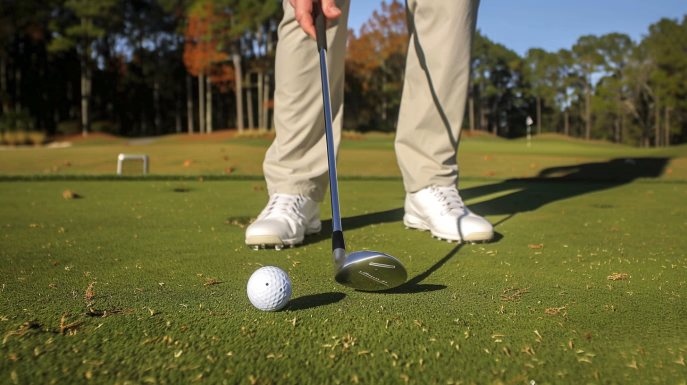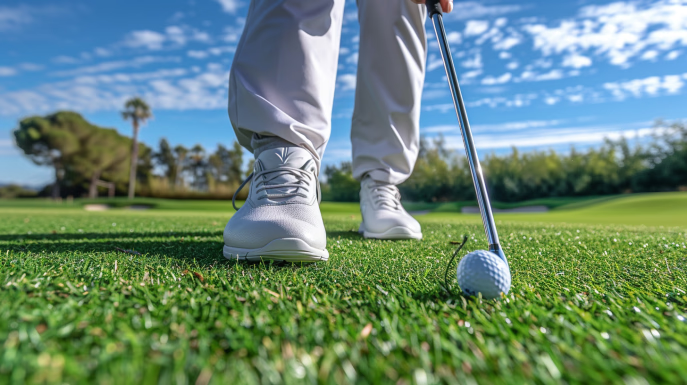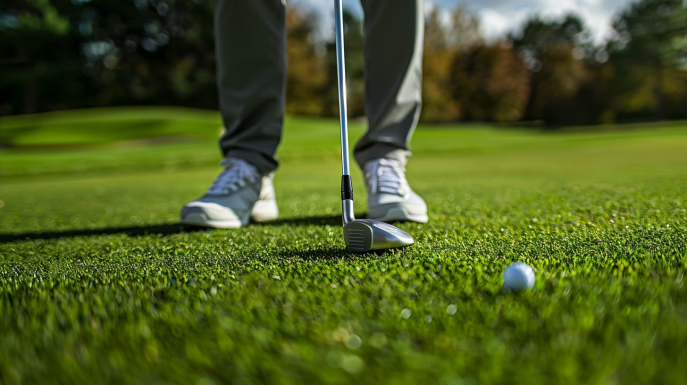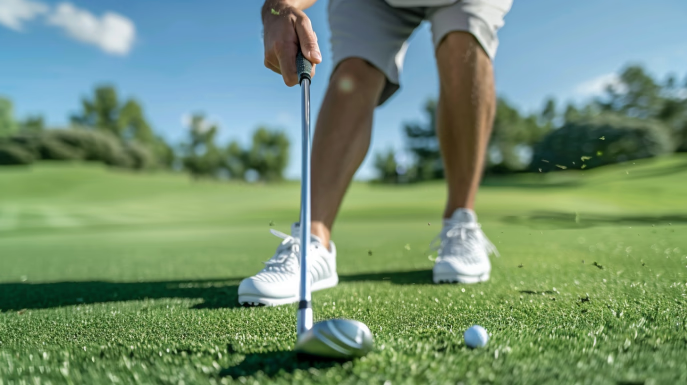Perfect Golf Grip and Stance: Unlock Your Swing Potential

Source : pinnaclegolfpros copyright
A proper grip and stance are crucial fundamentals for unlocking your full golf swing potential and achieving consistency on the course. This comprehensive guide will explore the key elements of grip and stance, providing expert insights and practical tips to help you refine your setup and maximize your performance. By understanding the impact of hand positioning, weight distribution, and body alignment, you’ll be able to develop a solid foundation for a powerful, consistent swing. Whether you’re a beginner or an experienced golfer, mastering the fundamentals of grip and stance can transform your game and take your scores to new heights.
Key Takeaways
- Proper grip and stance are essential for consistent and powerful golf swings.
- Understanding the impact of hand positioning, weight distribution, and body alignment is crucial for developing a solid swing foundation.
- Mastering the fundamentals of grip and stance can help golfers of all skill levels improve their performance on the course.
- Refining your grip and stance can lead to increased control, stability, and alignment in your swing.
- Developing a consistent grip and stance setup is essential for achieving proper technique, ergonomics, and form.
Understanding the Fundamentals of Grip and Stance

The grip and stance are the foundation of your golf swing, and understanding their fundamentals is crucial for achieving consistent and powerful ball striking. In this section, you’ll explore the importance of proper hand positioning on the club, including the various grip styles and how they impact your swing mechanics. Additionally, you’ll learn how to establish a solid base through optimal weight distribution and body alignment, which are essential for maintaining balance and generating maximum power throughout your swing.
The Impact of Proper Hand Positioning
Your hand positioning on the club is a critical component of your grip, as it directly influences your swing mechanics, clubface control, and overall consistency. Mastering the proper hand positioning, whether you choose an interlocking, overlapping, or Vardon grip, can help you achieve a more stable and repeatable swing path, allowing you to deliver the clubface to the impact zone with precision. By understanding the nuances of each grip style, you’ll be able to select the one that aligns best with your personal preferences and swing characteristics.
Establishing a Solid Base for Balance and Power
Developing a stable and balanced stance is essential for generating power and maintaining control throughout your swing. By optimizing your weight distribution and body alignment, you’ll create a solid foundation that enables you to transfer energy efficiently from your lower body to your upper body, resulting in a more consistent and powerful ball strike. Through various balance techniques, posture control, and shoulder positioning, you’ll learn how to establish a stance that not only supports your swing mechanics but also helps prevent injury and enhance your overall performance on the course.
| Grip Technique | Key Benefits | Impact on Swing Mechanics |
|---|---|---|
| Interlocking Grip | Maximizes control and consistency | Promotes a stable swing path and clubface control |
| Overlapping Grip | Enhances stability and swing path | Helps golfers maintain a more consistent swing tempo and power transfer |
| Vardon Grip | Provides precision and feel | Allows for greater control over shot shaping and clubface alignment |
Exploring Grip Types and Their Benefits
Golfers have a multitude of grip options to choose from, each offering unique advantages to enhance their swing mechanics and performance on the course. In this section, we’ll delve into two popular grip techniques: the interlocking grip and the overlapping grip, exploring how these methods can help players achieve greater control, consistency, and stability in their swing.
Interlocking Grip: Maximizing Control and Consistency

The interlocking grip, also known as the Vardon grip, is a classic technique that has been embraced by many professional golfers. By interlocking the little finger of the dominant hand with the index finger of the trailing hand, this grip style promotes a strong, unified connection between the hands, resulting in enhanced clubface control and a more consistent swing path. The interlocking grip helps golfers maintain a steady grip pressure and grip strength throughout the swing, allowing for better tension management and a more fluid, rhythmic swing tempo.
Overlapping Grip: Promoting a Stable Swing Path
The overlapping grip, or the Vardon grip, is another popular option that can provide golfers with a stable and consistent swing. In this technique, the little finger of the dominant hand overlaps the index finger of the trailing hand, creating a secure and comfortable hold on the club. The overlapping grip encourages a more controlled and stable swing path, helping players to maintain better clubface alignment and power transfer through the impact zone. This grip style is particularly beneficial for golfers who struggle with a tendency to slice or hook the ball, as it can help them achieve a more centered and reliable ball flight.
| Grip Type | Key Benefits | Ideal Player Profile |
|---|---|---|
| Interlocking Grip | – Enhanced clubface control – Consistent swing path – Stable grip pressure and strength |
– Golfers seeking a unified, connected feel – Players who value precision and consistency – Individuals with medium to larger hands |
| Overlapping Grip | – Promotes a stable swing path – Helps maintain clubface alignment – Facilitates efficient power transfer |
– Golfers prone to slicing or hooking – Players with a preference for a secure, comfortable hold – Individuals with smaller to medium-sized hands |
By understanding the nuances of these grip types, golfers can select the one that best aligns with their personal preferences, swing characteristics, and desired performance outcomes. Experimenting with different grips and finding the right fit can be a transformative step in unlocking your full potential on the course.
grip and stance
The grip and stance are essential components of the golf swing, and this section will delve into the Vardon grip, a classic technique that has stood the test of time. The Vardon grip, also known as the Vardon or overlapping grip, is a popular choice among golfers for its ability to provide exceptional control and feel in their shots. By understanding the nuances of this grip style, you’ll learn how to shape the ball with precision and consistency, unlocking your full potential on the course.
The Vardon Grip: A Classic for Precision and Feel
The Vardon grip, named after the renowned British golfer Harry Vardon, is characterized by the little finger of the dominant hand (usually the right hand for right-handed golfers) overlapping or interlocking with the index finger of the non-dominant hand. This hand position allows for greater control over the clubface, enabling you to impart the desired spin and trajectory on the ball. With the Vardon grip, you’ll experience enhanced clubface control, allowing you to execute a wide range of shots with precision aiming and swing tempo.
Grip Strength and Tension Management
Alongside the Vardon grip, the management of grip strength and tension is crucial for optimizing your swing mechanics and power transfer. Maintaining the right balance of grip pressure can significantly impact your ability to generate clubface control and swing tempo. By developing a feel for the appropriate level of grip pressure and tension management, you’ll be able to swing with confidence, minimizing unnecessary strain and maximizing your power transfer from the clubhead to the ball.
Stance Variations and Their Advantages
Golfers have the flexibility to adopt a range of stance positions, each offering distinct advantages to enhance their performance. In this section, we’ll explore the square stance and the closed stance, delving into how these setups can influence your swing path, weight distribution, and overall body mechanics.
Square Stance: A Balanced Foundation
The square stance, where your feet are aligned parallel to the target line, provides a solid and balanced foundation for your swing. This stance encourages a centered weight distribution, allowing for efficient transfer of power from your lower body to your upper body during the swing. By maintaining a stable and centered stance, golfers can generate consistent swing paths, leading to straighter ball trajectories and improved accuracy.
Furthermore, the square stance promotes a more natural and relaxed body alignment, reducing the risk of injury and enabling greater comfort throughout the swing. Golfers who prefer a more stable and controlled swing often find the square stance to be an excellent choice, as it helps them maintain a balanced and efficient movement pattern.
Closed Stance: Promoting an Inside-Out Swing Path

The closed stance, where your feet are positioned slightly closer to the target line than the square stance, can be advantageous for golfers seeking to promote an inside-out swing path. This setup encourages a more powerful rotation of the hips and shoulders, allowing for a more dynamic and versatile swing that can produce controlled draws and fades.
By shifting your weight slightly toward the target, the closed stance can also help you achieve a more centered impact position, optimizing your ball-striking consistency and distance control. This stance variation is particularly beneficial for players who struggle with an outside-in swing path or who want to shape their shots more effectively.
Mastering the nuances of different stance variations, such as the square stance and the closed stance, can empower golfers to adapt their setup to the specific demands of each shot, ultimately leading to improved performance and consistent results on the course.
Weight Distribution and Body Alignment
Achieving optimal weight distribution and body alignment is crucial for unlocking your full swing potential and preventing injury on the golf course. By carefully managing the balance and positioning of your body, you can generate maximum power transfer from your lower body to your upper body, resulting in a more efficient and consistent swing.
Unlocking Optimal Power Transfer
Proper weight distribution is the foundation for generating power generation in your golf swing. By ensuring your weight is evenly distributed across your feet and shifting it appropriately during the swing, you can harness the rotation dynamics of your body to transfer energy from your lower body to your upper body. This efficient power transfer will allow you to produce greater clubhead speed and distance, while maintaining balance and stability throughout the swing.
Preventing Injury Through Proper Posture
Maintaining body alignment and proper posture is not only crucial for your swing mechanics but also for injury prevention. By addressing common issues like excessive shoulder turn, weight shift, and flexibility imbalances, you can develop a more balanced and controlled swing that reduces the strain on your muscles and joints. Integrating comfort adjustments and biomechanics principles into your setup will help you maintain consistency in setup and muscle memory, ensuring long-term comfort and performance on the course.
Incorporating Grip and Stance into Your Practice Routine
Mastering the fundamentals of grip and stance is an ongoing process that requires dedicated practice and a commitment to building muscle memory. By incorporating targeted drills and exercises into your regular practice routine, you can ingrain the proper techniques, ensuring that your grip and stance become second nature on the course.
Drills for Developing Muscle Memory
One of the most effective ways to reinforce the correct grip and stance is through repetitive drills and practice. Begin by focusing on the individual elements, such as proper hand positioning, weight distribution, and body alignment. Perform these drills without a ball, allowing you to focus solely on the movement patterns and sensations. As you progress, incorporate the ball and gradually increase the complexity of the drills, challenging yourself to maintain the proper form and technique.
Some key drills to consider include grip positioning exercises, balanced stance setups, and club grip technique practice. By consistently executing these drills, you’ll develop the muscle memory and kinesthetic awareness necessary to execute your grip and stance with confidence on the course.
Video Analysis and Feedback Loops
Leveraging video analysis can be a powerful tool in refining your grip and stance. By capturing footage of your swing, you can observe your technique in detail and identify areas for improvement. Collaborate with a qualified golf instructor or use video analysis apps to provide objective feedback and help you make targeted adjustments to your setup.
Incorporating feedback loops into your practice routine is also crucial for optimizing your grip and stance. After each practice session or round, take the time to reflect on your performance, noting any successes or challenges. Use this information to inform your next practice plan, focusing on the specific areas that require further attention and refinement.
By combining targeted drills, video analysis, and feedback loops, you’ll be able to develop a consistent, efficient, and repeatable grip and stance that will serve as the foundation for your golf swing. Persistently integrating these practice techniques into your routine will help you build the necessary muscle memory and control to unlock your full potential on the course.
Adapting Grip and Stance for Different Playing Conditions
As golfers, we often find ourselves facing a variety of playing conditions, each presenting unique challenges that require a tailored approach to our grip and stance. Understanding how to adapt your setup for different environments is crucial in maintaining control, consistency, and precision on the course.
Adjustments for Wet or Firm Lies
When faced with wet or firm lies, the grip and stance must be adjusted to provide the necessary traction and control. On wet lies, a firmer grip with slightly more pressure can help prevent the club from slipping during the swing. Additionally, a slightly wider stance and a more centered weight distribution can enhance stability and prevent the club from digging too deeply into the soft, saturated ground.
Conversely, on firm lies, a lighter grip with a more relaxed hand position can help you maintain control and prevent the club from bouncing off the hardened surface. A narrower stance and a slightly forward weight shift can also assist in creating a smooth, controlled swing path through the impact zone.
Modifying Your Setup for Windy Conditions
Navigating windy conditions on the golf course requires a thoughtful adjustment to your grip and stance. To maintain control and precision in strong winds, consider a slightly stronger grip with more pressure in your hands. This can help you keep the clubface more stable and prevent it from twisting during the swing.
Additionally, a wider, more stable stance with your weight distributed evenly or slightly back can provide a solid foundation to counteract the effects of the wind. This setup can help you generate a more controlled, penetrating ball flight that cuts through the gusts and reaches your target with greater accuracy.
By understanding the nuances of adapting your grip and stance for varying playing conditions, you’ll be able to confidently tackle the challenges presented by wet lies, firm surfaces, and windy environments. Embrace these adjustments and unlock your ability to execute shots with precision and control, no matter the weather or course conditions you face.
The Role of Equipment Fit and Customization
The fit and customization of your golf equipment can have a significant impact on your grip and stance, and ultimately, your overall swing performance. Selecting the right equipment is crucial for achieving comfort, consistency, and optimal performance on the course.
Grip Size and Clubhead Weight Considerations
The size of your golf grip and the weight of your clubhead can greatly influence your ability to maintain control and precision throughout your swing. Ensuring a proper fit for your grip size can help you establish a secure and comfortable hold on the club, while the appropriate clubhead weight can contribute to a balanced and efficient swing path. By carefully considering these equipment factors, you can tailor your setup to your unique swing characteristics and physical attributes, resulting in a more consistent and confident performance.
Adapting Your Setup for Different Club Types
Golf clubs come in a variety of designs, loft angles, and shaft configurations, each catering to different playing styles and shot requirements. When adjusting your grip and stance, it’s essential to adapt your setup to the specific characteristics of the club you’re using. Whether you’re wielding a driver, fairway wood, or iron, making the necessary adjustments to your hand positioning, weight distribution, and body alignment can help you maximize the potential of each club type and execute a wide range of shots with precision and control.
Mental Focus and Visualization Techniques
Mastering the grip and stance is not just a physical endeavor; it also requires a strong mental approach. In this section, you’ll discover the power of mental focus and visualization techniques, including how to develop a consistent pre-shot routine and visualize your ideal swing path. By integrating these mental strategies into your practice and on-course performance, you’ll be able to maintain a calm, focused mindset and execute your shots with confidence and precision.
Developing a Pre-Shot Routine
A well-designed pre-shot routine can help you establish a mental focus and physical preparation before each swing. Begin by taking a few deep breaths to center yourself, then visualize the swing path, impact zone, and follow-through you want to achieve. Engage in a consistent set of physical movements, such as a waggle or a practice swing, to reinforce your muscle memory and build a sense of rhythm and timing. By consistently following this pre-shot routine, you’ll train your brain and body to work together seamlessly, reducing tension and pressure points while enhancing your overall mental focus and performance on the course.
Visualizing Your Ideal Swing Path
Incorporating visualization techniques into your practice routines and pre-shot preparation can have a profound impact on your swing mechanics and feedback loops. Close your eyes and vividly imagine the perfect swing path, impact zone, and follow-through. Visualize the ball’s trajectory, the visual cues you’ll see, and the sensations you’ll experience throughout the swing. This mental exercise can help your brain and body work in harmony, reinforcing the neural pathways associated with your ideal swing and allowing you to execute with greater consistency and precision on the course.
Grip and Stance Tips for Specific Player Groups
While the fundamental principles of a proper golf grip and stance apply to all players, certain adjustments and considerations may be needed to cater to the unique needs of different player groups. In this section, we will explore specialized tips for senior golfers and youth players, helping them optimize their performance and unlock their full potential on the course.
Senior Golfers: Maximizing Comfort and Control
As golfers advance in age, maintaining comfort and control become increasingly important. For senior players, the focus should be on finding a grip and stance that provides a stable foundation while minimizing strain on the joints and muscles. This may involve experimenting with different grip techniques, such as the interlocking grip or the Vardon grip, to find the most ergonomic and comfortable setup. Additionally, seniors should pay close attention to their posture and body alignment, ensuring they maintain a balanced stance that promotes stability and control throughout the swing.
Youth Training: Establishing Proper Fundamentals Early
For young golfers, the emphasis should be on building a solid foundation in proper grip technique and golf stance fundamentals. By instilling these essential skills early on, youth players will develop the necessary muscle memory and body control to build a consistent, powerful swing. Coaches and instructors should focus on performance drills that reinforce proper hand positioning, balanced weight distribution, and aligned body posture, setting the stage for long-term golfing success.
Professional Insights and Personalized Coaching
Elevating your golf game to new heights often requires the expertise and guidance of seasoned professionals. Working with a PGA-certified instructor can be an invaluable asset in refining your grip and stance, as these experts possess a wealth of knowledge and experience in optimizing swing mechanics and body alignment.
The Value of Working with a PGA Instructor
PGA instructors have a deep understanding of the fundamentals of the golf swing, including the critical role that grip and stance play in achieving consistent performance. Through personalized coaching, they can provide tailored insights and feedback to help you identify and address any weaknesses or imbalances in your setup, empowering you to develop a solid foundation for a more powerful, accurate, and repeatable swing.
Custom Fitting Sessions for Optimal Setup
Alongside personalized coaching, custom fitting sessions with PGA-certified experts can further enhance your grip and stance performance. These specialized fittings ensure that your golf equipment, from the size and grip of your clubs to the weight and design of the clubhead, are perfectly matched to your individual needs and swing characteristics. By optimizing your equipment fit, you’ll be able to achieve greater comfort, control, and precision in your setup, unlocking your full potential on the course.
| Benefit | Description |
|---|---|
| Personalized Insights | PGA instructors analyze your unique swing mechanics and provide targeted feedback to help you refine your grip and stance. |
| Optimized Equipment Fit | Custom fitting sessions ensure your clubs are perfectly tailored to your body, swing, and performance needs. |
| Improved Consistency | With a solid foundation and personalized coaching, you’ll develop a more consistent and repeatable swing. |
| Increased Confidence | Mastering the fundamentals of grip and stance boosts your confidence, allowing you to play with greater freedom and focus. |
Conclusion
In conclusion, the golf grip and stance are foundational elements that play a crucial role in unlocking your full swing potential and achieving consistent performance on the course. By mastering the proper techniques, understanding the benefits of different grip and stance variations, and adapting your setup to various playing conditions and equipment, you’ll be well on your way to taking your game to new heights.
Remember, the journey to golf mastery is an ongoing process, so continue to practice, seek guidance from professionals, and embrace the challenges and rewards that come with refining your grip and stance. With dedication and a commitment to improvement, you’ll be able to unleash your golfing prowess and enjoy the game at a whole new level.
Mastering the fundamentals of grip and stance, coupled with a keen focus on body alignment, balance techniques, and posture control, will unlock your ability to generate consistent power and performance on the course. By establishing a solid setup and consistency in your approach, you’ll see measurable improvements in your overall golfing success.
FAQ
What is the importance of a proper grip and stance in golf?
The grip and stance are the foundation of the golf swing, and mastering these fundamentals is crucial for achieving consistent and powerful ball striking. A proper grip and stance help golfers maintain balance, generate maximum power, and execute shots with precision and control.
What are the different types of grips available in golf, and what are their benefits?
Golfers have several grip options to choose from, including the interlocking grip, the overlapping grip, and the Vardon grip. Each grip type offers unique benefits, such as increased control, stability, and feel, allowing golfers to select the one that best suits their personal preferences and swing characteristics.
How does weight distribution and body alignment impact the golf swing?
Proper weight distribution and body alignment are essential for generating power, maintaining balance, and preventing injury in the golf swing. Optimizing these factors can unlock maximum power transfer from the lower body to the upper body, resulting in a more efficient and consistent swing.
What are some common stance variations, and how do they affect the swing?
Golfers can adopt different stance positions, such as the square stance and the closed stance, each with its own advantages. These stance variations can influence the swing path, weight distribution, and overall body mechanics, allowing golfers to tailor their setup to the specific demands of the shot.
How can golfers incorporate grip and stance practice into their routine?
Developing muscle memory and refining the grip and stance requires dedicated practice. Golfers can benefit from drills and exercises designed to ingrain the proper technique, as well as video analysis and feedback loops to identify areas for improvement and make necessary adjustments.
How can equipment fit and customization impact grip and stance performance?
The fit and customization of golf equipment, such as grip size and clubhead weight, can have a significant impact on a golfer’s grip and stance. Ensuring that the equipment is properly tailored to individual needs and swing characteristics can lead to a more comfortable and consistent setup, ultimately improving overall performance on the course.
What mental strategies can golfers use to enhance their grip and stance?
Mastering the grip and stance requires not only physical technique but also a strong mental approach. Golfers can benefit from developing a consistent pre-shot routine and visualizing their ideal swing path, helping them maintain a calm, focused mindset and execute their shots with confidence and precision.
How can golfers of different age groups and skill levels adapt their grip and stance?
The grip and stance requirements can vary depending on the age, skill level, and physical characteristics of the golfer. Specialized tips and techniques, such as maximizing comfort and control for senior golfers or establishing proper fundamentals early on for youth players, can help golfers of all backgrounds develop a solid foundation and unlock their full potential on the course.
What are the benefits of working with a PGA-certified golf instructor for grip and stance optimization?
Working with a PGA-certified golf instructor can be invaluable in refining a golfer’s grip and stance. These professionals can provide personalized coaching, offering tailored insights and guidance to help optimize swing mechanics, body alignment, and equipment fit, ultimately enhancing the golfer’s performance on the course.

